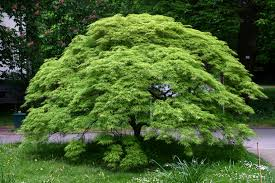Staking for the Japanese maple trees
Staking for the Japanese maple trees is very important to ensure that the tree grows in the desired direction intended, and it is supported and protected until it had grown to sufficient strength to handle all that the natural elements of the climate bring to it, like wind and rain, and other influences from outside .
Japanese maple tree can be planted similar to any other plant, which involves digging up a hole in the ground if a site is chosen in the garden. Roots should be fully covered under the soil and the ground should be levelled according to the surroundings. The delicacy of maple tree is appreciated throughout the world but it brings the issue of tolerance of heavy wind as well. Winds can severally damage the tree if no prior arrangements are ensured. If your area is known for heavy winds throughout the year or for any particular season of year then try to choose a site that can reduce the pressure of the wind. This becomes mandatory if you are planting the tree in the garden instead of indoor. By reducing the pressure of wind the safety of the tree can be ensured.

Staking for the Japanese maple trees explained
Even if you have chosen a perfect site for the tree still it is advised that for the first couple of years Staking should be done to avoid any undesirable event. Staking is a process in which the tree is tied to a stake to provide it a much needed support. The exact specification of staking depends upon the size and adaptability of the chosen tree. There is another important factor that decides the exact nature of the staking, it is the wind. It should be known prior to the process that what maximum pressure of the wind the site often witness. The direction of the wind plays an important role as well in determining the nature of staking. The low stake is the most preferred way to start as it doesn’t take away the natural movement of the tree, consequently which is vital for the natural growth. But if the area is notorious for its wind effect then the risk should be minimized by going for a high stake.
Staking for the Japanese maple trees step by step
There are some general known rules that usually are described in accordance with the height of the tree. Take for an instance, a tree which is taller than 10 feet requires two stakes lower in stature on the opposite directions of the tree. The same principle of growth and flexibility applies here, that says that the ropes should be tied in such a manner that may not become any hurdle in the natural growth of the tree. If this principle is ignored than over the time, the bark of the damage will be damaged due to the resistance.
As staking is not a new process but have remained standard procedures for centuries so for this reason the available equipment and tools have become more sophisticated. Ties with the buckles can be easily obtained from any nursery. There is abundant help available online about the specific steps to complete this process. Moreover now with the advancement in the technology you ca easily locate the steps by step video which will really solve any ambiguity latent in the textual description. Now you can easily learn this process and many more through video tutorials of gardening.
Staking doesn’t mean that the tree should be tied so strongly that it can not even move slightly, the experts suggest a bit lenient picture of the whole process. There should be enough elasticity in the attached ropes that it may move back and forward in the wind, if this is not ensured the damage of bark is inevitable in case of strong wind. Moreover this will allow the roots to gain more strength and this is much similar a case as when doctors suggest minimal use of medicine so that the body may develop its own defence mechanism. And eventually the tree will develop its own defence mechanism against the strong winds and staking will not be required after two or three years. If the region is not known as windy then the process of staking can be dropped because it demands particular attention from the gardener and sometimes take away the charm and beauty of the tree for couple of years.
Thank you for visiting this http://whentoplanttrees.com/ website and reading this Staking for the Japanese maple trees article. If you enjoy reading articles about Eye Vision health, then please do visit website http://healthyeyes.eu
There is also a Face Book page with the same name. Please do share your generous like for Healthy Eye Vision. Thanks!
Leave a Reply